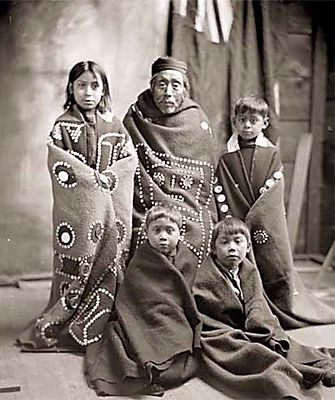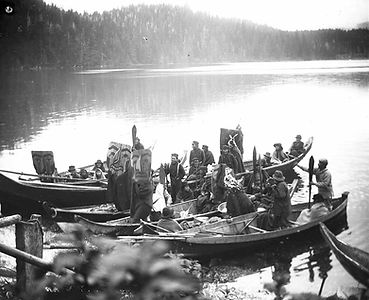In 1966, primarily to provide the sixteen families living in Quattishe with better access to medical services, education and employment opportunities, the Quatsino Subdivision IR #18 was created about 2km inland from Coal Harbour. Within five years all band members had moved to their new village site. Today’s Quatsino Band is a member of the Kwakiutl District Council and, for treaty negotiation purposes, the Winalagalis Treaty Group which includes three other members of the Kwakiutl District Council (the Da'naxda'xw Awaetlatla Nation, Gwa'Sala-Nakwaxda'xw Nation, and the Tlatlasikwala Nation.
Quatsino First Nations map of historic territory: https://en.wikipedia.org/wiki/Quatsino_First_Nation#/media/File:Quatsino.png
First Nation
The Quatsino First Nation historic home was based in the Quatsino Sound region on the west coast of northern Vancouver Island. Around 1890 four Kwakwaka’wakw tribal groups, with west coast village sites from Raft Cove to Brooks Peninsula, began joining together in the ancient village of Xwatis. The traditional populations of the T’latsinuxw (Klaskino), Gusgimukw (Koskimo), Gop’inuxw (Giopino) and Qwat’sinuxw (Quatsino) had been decimated over the previous 150 years largely due to disease and tribal warfare following the arrival of European explorers and fur traders.
In 1893 the Federal Government officially designated 250 acres of land around Xwatis, plus all the small islands just off shore, as Quattishe IR #1. This area is approximately 4km east of the current hamlet of Quatsino.



European Colonists
An exhibit sponsored by the BC government at the 1893 Chicago’s World Columbian Exposition was aimed to attract well-to-do farmers into the province by offering free land to prospective colonists through Crown Grants. A group of Norwegian farmers from Fargo, North Dakota jumped at the opportunity to create a new settlement in the wilds of BC.
In the winter of 1894 a steam ship full of enthusiastic men, women and children arrived in Quatsino Sound with supplies and provisions to begin their new life. They scouted out the area with help of the local First Nations and chose what they hoped would be ideal farming land for their new colony. Thirty 80 acre lots were surveyed along the shores of Quatsino Sound and land clearing began. Within a year the Quatsino Post Office was in business, a small Government Wharf was built, a saw-mill was in operation, the Norgar General Store opened and a monthly freight service from Victoria was established. Within three years a one-room school was built and a teacher hired to teach 17 school aged children. John Satre, the great great great uncle of current Quatsino resident Kim Justinen, was the first School Superintendent.
The community thrived over the years as the economy in the Quatsino Sound area grew; Yreka and Benson Lake mines were developed, Port Alice pulp mill was built, forestry and mineral claims offices opened, fish canneries and processing plants opened, a busy saloon and three general stores were in operation, a Customs Officer and RCMP Constable were hired, an Imperial Oil fuel station opened, the Dominion Government Telegraph Service kept the settlers connected to the outside and the five room Quatsino Hotel plus seven rental cabins in Akreville were built for workers and visitors to the area.
Land for a new Cemetery was bought by the community as the life on the land and sea took its toll. In 1929 two acres of land was sold to the Quatsino Board of School Trustees for $1.00 so a larger two-room school could be built for the 36 students who had outgrown their tiny one room school.
Currently Available
The Quatsino Chronicle
1894 - 2005
Second Edition 258 pages on the fascinating history of Quatsino -$30.00 (+ S/H for mail outs) All profits from sales will go to the Quatsino Archives Association. Books can be purchased at the Quatsino Museum or ordered for mailing through quatsino.museum@recn.ca or aghansen@recn.ca.
Formed in 1992, the Quatsino Archives Association preserves the history of Quatsino and the greater Quatsino Sound region for the people of the community and all who supportour goals. To accomplish this, our new museum will archive and showcase the history of our region making it accessible and meaningful to all members of the community, promoting an appreciation of Quatsino’s diverse cultural, social and economic heritage.

Underwater telephone lines were laid across Holberg Inlet from Coal Harbour in the early 20’s and from the Quatsino Hotel across to Evenson Point and down to Port Alice. Wires strung from tree to tree within the Community connected 6 homes and businesses to the outside world. It wasn’t until the early 1970’s that proper poles were installed and electricity arrived to allow coal oil lamps and gas generators to be stored away. Private phone lines became available in 1995 and opened up the community to internet service.
Today a touch of the past is still evident. We still choose to retain our connection with the sea as our highway. We are able to enjoy all the basic comforts that one could desire while we hold onto our unique rural lifestyle. The first school is now St. Olaf’s Anglican Church where weddings, Christenings and special services are held. The ‘new” Quatsino School celebrated its 70th anniversary in 2004 with a hugely successful School Reunion weekend. The Quatsino Hotel has been renamed Eagle Manor Resort and attracts visitors from around the world. Changes to fishing regulations have resulted in the commercial fisheries largely being replaced by sport fishing. The Government still maintains the Wharf, the Cemetery, the Post Office and the 8 mile single lane gravel road through the community.
Families with deep roots still reside in Quatsino or hold title to homesteads their great, great - grandparents once toiled over; but new blood is becoming dominant. Of the original 19 Quatsino homestead properties surveyed in 1895, only one remains as an 80 acre waterfront lot. The rest have been divided over the years into over 135 lots ranging in size from 0.1 acre to 40 acres. Today around 26 properties are home to year-round residents, 50 by summer residents and the rest are either undeveloped properties, wood lots or Crown Land leases held by private companies or by WFP.

The museum will also make available for public and scholarly use our collections and data through exhibitions, education programs, and research services. PHASE ONE of the project focuses on creating the museum site and building which will be completed before the end of the summer of 2007, in preparation for PHASE TWO, the expansion of the display area and preparations for the grand opening in 2008. The museum will then continue to grow from year to year.The permanent collections will focus on the natural history, first nations history, and colonial history, as well as the area’s traditional industrial history. Documents, photos, artifacts, art, and memoribilia from the Quatsino area are currently being sought. If you have something that might enhance the permanent collection, please contact us soon.

